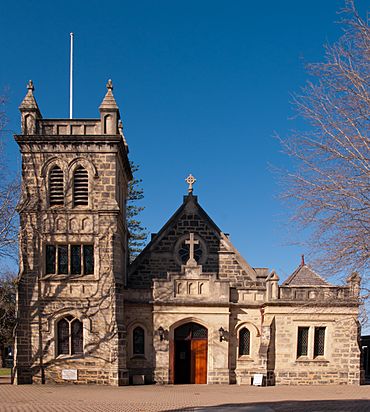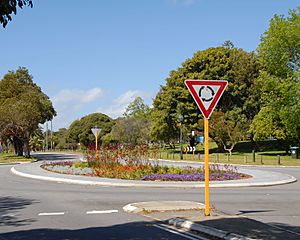Claremont, Western Australia facts for kids
Quick facts for kids ClaremontPerth, Western Australia |
|||||||||||||||
|---|---|---|---|---|---|---|---|---|---|---|---|---|---|---|---|

Christ Church, Claremont. Built 1892.
|
|||||||||||||||
| Established | 1890s | ||||||||||||||
| Postcode(s) | 6010 | ||||||||||||||
| Area | 3.6 km2 (1.4 sq mi) | ||||||||||||||
| Location | 9 km (6 mi) WSW of Perth CBD | ||||||||||||||
| LGA(s) |
|
||||||||||||||
| State electorate(s) | Cottesloe | ||||||||||||||
| Federal Division(s) | Curtin | ||||||||||||||
|
|||||||||||||||
Claremont is a suburb located in the western part of Perth, Western Australia. It sits on the northern bank of the Swan River. It's known for its mix of beautiful homes, shopping areas, and important community facilities.
Contents
History of Claremont
Early Days and Settlement
Before European settlers arrived, the Noongar people lived in the Claremont area. They used the land for fishing and finding water and birds. It was an important place for them.
In 1830, a settler named John Butler opened an inn at Freshwater Bay. This inn was meant to help travelers going between Perth and Fremantle. A nearby wetland became known as Butler's Swamp, which is now Lake Claremont.
When convicts (prisoners sent from Britain) arrived in 1850, they helped build the Fremantle Road. The government gave land to 19 Pensioner Guards (retired soldiers) and their families. A special place for convicts also operated at Freshwater Bay until 1875.
Growth of the Community
A school was built in 1862, followed by a church. A community started to grow around what is now Victoria Avenue. A settler named James Morrison bought land and named it Claremont Estate. He named it after his wife, Clara.
During the 1870s, several important families bought land in the area. Some of their homes were later bought by Christ Church Grammar School.
In 1881, a railway line was built from Perth to Fremantle. A train station was added at Butler's Swamp, and its name changed to Claremont in 1883. This made the area around the railway line, Fremantle Road (now Stirling Highway), and Bay View Terrace the new center of the community. The old Freshwater Bay school became a boarding house and later a museum.
People bought land in the area and divided it into different sized blocks. This led to a mix of people from different backgrounds living in Claremont. By the time of the Second World War, Claremont was a well-established community.
Claremont's Location
Claremont has clear boundaries. Airlie Street is to the south, and Stirling Highway, Parry Street, and Stirling Road are to the west. Alfred Road is to the north, and Loch Street and Bay Road are to the east.
Most of Claremont is residential, meaning people live there. However, there's also a big shopping area along Stirling Highway. The Claremont Showground and the eastern part of Lake Claremont are also within Claremont's borders.
Some parts of Claremont, like the Agett Road and Richardson Avenue areas, have very grand homes. Other areas, like those around Ashton Avenue, have smaller homes.
People in Claremont
In 2016, about 8,148 people lived in Claremont. Most people (61.1%) were born in Australia. Other people came from countries like England (8.5%), South Africa (1.9%), China (1.9%), and New Zealand (1.7%).
Most people (78.3%) spoke only English at home. Mandarin was the next most common language, spoken by 2.1% of people. When it came to religion, many people said they had no religion (32.2%). Others were Anglican (21.3%) or Catholic (19.1%).
Many people in Claremont work in hospitals, universities, and schools. Other popular jobs are in legal services, cafes, and restaurants.
Homes in Claremont include separate houses (46.5%), semi-detached homes (25.3%), and flats or apartments (27.5%).
Places to Visit and Use
Claremont has several important places. These include the Claremont Showground and the Claremont Oval, which is the home ground for the Claremont Football Club. There's also a large shopping area along Stirling Highway, especially in the St Quentins Avenue area.
Many private schools are in or very close to Claremont. These include Methodist Ladies' College, Christ Church Grammar School, Presbyterian Ladies' College, John XXIII College, and Scotch College. Claremont also has a small private hospital called Bethesda and one public primary school, Freshwater Bay Primary School. There are also jetties on the Swan River.
The Perth Royal Show, a big annual event with farm animals and fun rides, is held at the Claremont Showground. The Showground also hosts other large events and music festivals throughout the year.
Claremont has several buildings that are important for their history. These include the Claremont Post Office and the unique weatherboard ANZAC Cottage.
Getting Around Claremont
Claremont has good public transport. It is served by the Claremont railway station and Loch Street railway station. The Showgrounds railway station is also open during special events. Many buses, including the CircleRoute, travel along Stirling Highway and through different parts of Claremont. All these services are run by the Public Transport Authority.
Bus Services
- Buses like the 23, 24, and 25 connect Claremont Station to places like Elizabeth Quay Bus Station and Shenton Park Station.
- Other buses, like the 27 and 28, serve areas like Stirling Road and Alfred Road, going to East Perth and Perth Busport.
- Buses 102, 103, and 107 connect Claremont to Cottesloe Station, Elizabeth Quay Bus Station, and Fremantle Station.
- The high-frequency 995 bus also goes from Claremont Station to Elizabeth Quay Bus Station.
- The CircleRoute buses (998 and 999) travel around the city, passing through Claremont on Stirling Highway.
Train Services
- The Fremantle/Airport Line trains stop at Loch Street Station, Showgrounds Station (for events), and Claremont Station.
- The Fremantle Line also has a stop at Swanbourne Station nearby.
Famous People from Claremont
Claremont has been home to several notable people:
- Jessie Forsyth (1847/49 – 1937), who was a strong supporter of the temperance movement (against alcohol).
- Kimberley Michael (Kim) Durack (1917–1968), an agricultural scientist.
- Adelaide Kane (born 1990), a well-known actress.
- Sheila Mary McClemans (1909–1988), a lawyer and naval officer.
- Donald Alexander Stockdrill (1923–1980), a civil engineer.
- Colin Syme (1903–1986), a successful businessman.
- Gwyn White (née Shirley) (1913–2020), who was the first female umpire for the Davis Cup tennis tournament.



